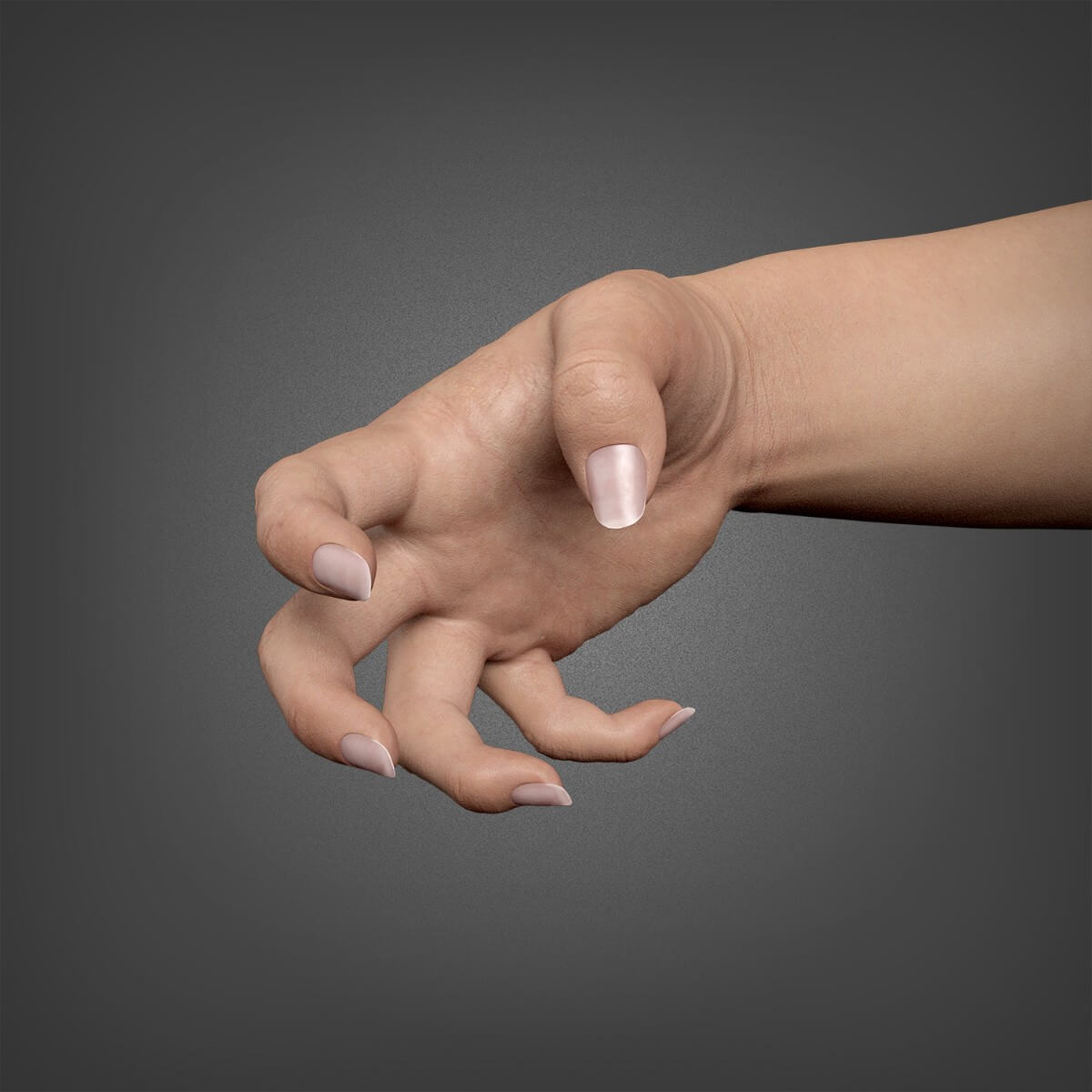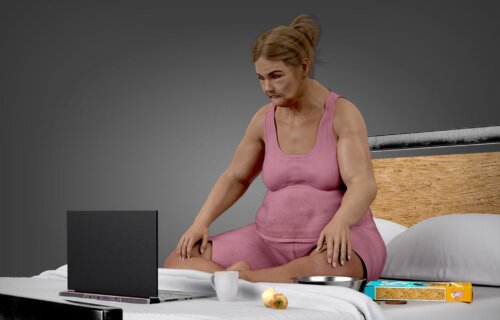GLASGOW, Scotland — There’s nothing better than working from home, right? Well, a new study examining the future of the workplace might have you running back to your office at warp speed! Based on expert opinions and studies looking at the impact of remote work on health, researchers from Furniture@Work have created a shocking 3D model of what future remote workers could look like in a worst-case scenario.
From poor posture to claw-like hands and swollen eyes, here’s what the future could look like — meet “Anna”:

The Scottish team notes that the COVID-19 pandemic led to world-changing shifts in what people consider the “normal” workday. Even as the pandemic officially ends, workers are still trading their offices for home bedrooms and kitchen tables. While many companies attempt to force their employees back to the workplace, many others are simply accepting that hybrid and remote work schedules are the new normal.
Although remote workers may love their new-found freedom now, “Anna” represents a collection of potential health issues that experts say could arise from a long-term, work-from-home schedule. According to the team, consistent use of laptops and smartphones, poor posture, and regularly consuming an unhealthy diet may lead to shocking physical changes for future humans.
Furniture@Work researchers asked a team of health experts to examine each of these bad habits and the implications for remote employees like “Anna.”
Poor posture on the sofa could give you a hunchback
Previous studies have shown that constantly using digital devices can lead to poor posture. With people working from home more and more, this means many people are sitting on sofas or beds while hunching over their laptops for hours. Working like that for years could throw off the balance of your spine and pull your torso in front of your hips — creating a hunchback appearance.

“Lack of regular movement and ergonomic inefficiencies can lead to musculoskeletal disorders (MSD). Chronic pains and degenerative conditions can also develop because of prolonged sitting and inadequate posture (especially when no one is watching),” says Dr. LS Wang, an internationally published orthopedic surgeon with more than 18 years of clinical experience, in a statement.
“Poor ergonomics or inadequate furnishings can cause adverse side effects, including neck and back pain and carpal tunnel syndrome,” adds Dr. Sony Sherpa, a holistic physician from Nature’s Rise, an organic wellness company.
To avoid back and neck pain, the doctors recommend taking regular breaks and stretching. Ergonomic furniture that supports posture may also relieve these symptoms.
Look out for the claw hand!

Just like a previous study that examined the potential deformities of future tech users, this model also found that Anna could develop a claw hand from overusing digital devices.
“Text Claw” is a non-medical term which describes when the fingers cramp up from continuously performing fine motor activities. In a remote worker’s case, that means hours spent using a smartphone, curling their hand in an unnatural position.
Screen time is scary time for your eyes
There is no shortage of studies on the negative impact of screen time, for workers and kids. Anna shows how excessive screen time could damage the eyes, especially if a remote worker’s home environment is too dark. Researchers found that without having enough natural light or bright lights like in offices, remote workers end up putting extra strain on their eyes, leading to other problems like headaches.

“Try to look away from your screen every 20 minutes for 20 seconds and focus on something 20 feet away. This is a great way to avoid eye strain while working from home,” says Sarah Gibson, Director of Proactive Healthcare.
Sitting all day can lead to weight gain and worse
Remote work generally means those frustrating commutes to the office each day are long gone. While that may sound great, it also means the only commuting some people are doing is between their bed and the refrigerator!
“Without the need to commute to work, many people find that they become more sedentary, leading to weight gain and a higher risk of developing chronic health conditions such as diabetes and heart disease,” says Dr. JB Kirby, a doctorate-prepared nurse practitioner with 38 years of experience.

“You are more likely to live a sedentary lifestyle when working from home. This physical inactivity can put you at a greater risk of developing cardiovascular diseases, diabetes, and obesity,” Dr. Sony Sherpa adds.
Along with all of these physical ailments, researchers also noted the potential for mental health problems developing from the remote work lifestyle.
“Without a precise work-life balance, no office hours, or a set location to go back to at the end of each workday, the anxiety of not knowing when to ‘switch off’ can become overwhelming. We can start to feel like we are never truly away from work, which can lead to burnout,” notes, Joni Ogle, LCSW, CSAT, CEO of The Heights Treatment.
“Long-term health risks of working from home include mental health concerns such as stress, loneliness, and burnout. To avoid these risks, remote workers should prioritise social connection and self-care, and establish clear boundaries between work and personal time,” concludes Brian Clark, BSN, MSNA and Founder of United Medical Education.
Editor’s note: The report above, very clearly, comes away with an extreme prediction. Though our writers individually may heavily disagree with or may heavily agree with a story, they must still present the findings to the reader as presented by the researchers. Our content is intended to stir debate and conversation, and we always encourage our readers to discuss why or why not they agree with the findings. We do not receive any compensation from the researchers, marketing firms, or anyone else behind the research for the content we post. We share who commissioned research (who paid for the study not to StudyFinds, but to the people who completed the research) to give additional transparency to the reader so that they can weigh that in their conclusions about the report. If you heavily disagree with a report — please debunk to your delight in the comments below.


This is funny but hopefully motivating to people who realize remote work DOES WORK. I have desk that extends vertically from under 3 feet to about 4.5 feet and higher. I change positions all day long. I wear a weighted vest and use muscle electric stimulation pads on a day-to-day basis. I try to eat balanced meals, but that’s the biggest challenge is eating quality meals and not snacking. You have to take care of your body. Working in an office cubicle can be just as detrimental to one’s health and results in “Anna”-like outcome. Where the AI simulation for that?! I choose work-life balance through remote working.
Commercial real estate owners trying to use fear mongering to get employees back into their slavish cubicles
LOL. Desk jobs are just as bad. At least with working from home you can get up and move about at regular intervals. You also have more freedom to dictate the set up that you will be working at. Sometimes this means workspaces that promote better posture and mobility. This is definitely fear mongering. The animation makes it all the more laughable.
Staring at a screen for hours with a non-ergonomic desk and not getting exercise sounds like THE OFFICE to me. Let me guess, the study was carried out by a company that makes OFFICE furniture. LOL